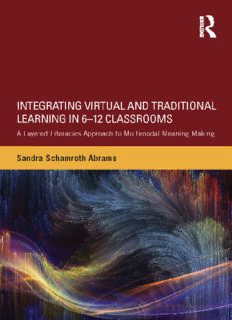
Integrating Virtual and Traditional Learning in 6-12 Classrooms: A Layered Literacies Approach to Multimodal Meaning Making PDF
Preview Integrating Virtual and Traditional Learning in 6-12 Classrooms: A Layered Literacies Approach to Multimodal Meaning Making
INTEGRATING VIRTUAL AND TRADITIONAL LEARNING IN 6–12 CLASSROOMS Integrating Virtual and Traditional Learning in 6–12 Classrooms introduces a model of “layered literacies” as a framework for describing and illustrating how students’ digital experiences can inform educational methods. Through the lens of layered literacies, educators can envision opportunities to draw upon adolescents’ out-of- school interests and activities to meaningfully integrate digital practices within academic contexts. Such an approach facilitates innovative teaching, inspired learning, and successful pedagogy, and it thoughtfully highlights the role of technology within mandated standards-based instruction in public schools. Combining foundational and contemporary theories and supported by data from multiple studies of adolescent learning, this text: • helps educators reconceptualize the ways students learn through and with digital texts and negotiate the connection between online and offline spaces; • offers a layered literacies framework that is flexible and customizable, sustain- ing differentiated and individualized learning opportunities; • incorporates a range of alternatives to accommodate classrooms with limited or unreliable technology; • honors teachers’ and students’ experiences and resources, while offering ideas for modification and growth; • features vignettes of classroom practice written by classroom teachers and education researchers; • provides a window into effective, cross-disciplinary techniques that build upon layered literacies. Online resources to accompany the text (www.routledge.com/9780415656597) complement the concept of layering literacies across disciplines. With a foreword by Jennifer Rowsell and an afterword by Bill Cope and Mary Kalantzis, Integrating Virtual and Traditional Learning in 6–12 Classrooms will be of interest to experienced educators and administrators, as well as postgraduate, graduate, and undergraduate students of education. Sandra Schamroth Abramsis an Assistant Professor of Adolescent Education in the School of Education, St. John’s University, Queens, New York, USA. INTEGRATING VIRTUAL AND TRADITIONAL LEARNING IN 6–12 CLASSROOMS A Layered Literacies Approach to Multimodal Meaning Making Sandra Schamroth Abrams First published 2015 by Routledge 711 Third Avenue, New York, NY 10017 and by Routledge 2 Park Square, Milton Park, Abingdon, Oxon, OX14 4RN Routledge is an imprint of the Taylor & Francis Group, an informa business © 2015 Taylor & Francis The right of Sandra Schamroth Abrams to be identified as author of this work has been asserted by her in accordance with sections 77 and 78 of the Copyright, Designs and Patents Act 1988. All rights reserved. No part of this book may be reprinted or reproduced or utilised in any form or by any electronic, mechanical, or other means, now known or hereafter invented, including photocopying and recording, or in any information storage or retrieval system, without permission in writing from the publishers. Trademark notice: Product or corporate names may be trademarks or registered trademarks, and are used only for identification and explanation without intent to infringe. Library of Congress Cataloging in Publication Data Library of Congress Control Number: 2014944461 ISBN: 978-0-415-65658-0 (hbk) ISBN: 978-0-415-65659-7 (pbk) ISBN: 978-0-203-07767-2 (ebk) Typeset in Bembo by Keystroke, Station Road, Codsall, Wolverhampton To my children— May the sparks of your imagination and creativity continue to ignite possibilities. To my husband— Thank you for believing. This page intentionally left blank BRIEF CONTENTS List of Figures xiii List of Spotlight Vignettes xv Foreword:Layering Life into Literacy xvii Jennifer Rowsell Acknowledgements xxi 1 Introduction:Integrating Virtual and Traditional Learning— The Online–Offline Connection 1 2 A View from Inside the Fishbowl:A Culture of Layered Understandings 9 3 Teaching,Assessment,and Layered Literacies 27 4 Making Classroom Material Relevant Through Layered Literacies 47 5 Layering the Classroom Experience 59 6 Creating a Rhythm-Based Culture that Layers Approaches to Bridging In- and Out-of-School Practices 75 viii Brief Contents 7 But the Internet Is Down! Layering Literacies With (and Despite) Technology in the Classroom 91 8 Rethinking Classroom Learning:Affordances of Technological Change and Opportunities for Inspired Pedagogy 109 Afterword:Literacies of Life Meet Literacies of School 117 Bill Cope and Mary Kalantzis References 125 Index 133 CONTENTS List of Figures xiii List of Spotlight Vignettes xv Foreword:Layering Life into Literacy xvii Jennifer Rowsell Acknowledgements xxi 1 Introduction:Integrating Virtual and Traditional Learning—The Online–Offline Connection 1 Technology and the Classroom 2 What This Book Offers 5 What This Book Is Not 7 Looking Ahead 7 2 A View from Inside the Fishbowl:A Culture of Layered Understandings 9 Introduction 9 Looking Back to Move Forward:An Overview of Research and Thinking about Literacies 10 What This All Means in Terms of Technology and Layered Literacies 14 The Layered Literacies Frame 15 A Culture of Participation 18 Agency 18
Description: